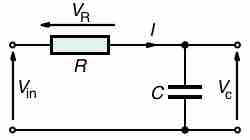Rather than solving the differential equation relating to circuits that contain resistors and capacitors, we can imagine all sources in the circuit are complex exponentials having the same frequency. This technique is useful in solving problems in which phase relationship is important. The phase of the complex impedance is the phase shift by which the current is ahead of the voltage.
Complex Analysis
For an RC circuit in , the AC source driving the circuit is given as:

Series RC Circuit
Series RC circuit.
where V is the amplitude of the AC voltage, j is the imaginary unit (j2=-1), and
- We use lower case alphabets for voltages and sources to represent that they are alternating (i.e., we use vin(t) instead of Vin(t)).
- The imaginary unit is given the symbol "j", not the usual "i". "i" is reserved for alternating currents.
Complex Impedance
The advantage of assuming sources take this form is that all voltages and currents in the circuit are also complex exponentials (having the same frequency as the source). To appreciate the reason for this, we can investigate how each circuit element behaves when either the voltage or current is a complex exponential. For the resistor,
The major consequence of assuming complex exponential voltage and currents is that the ratio
Finding Real Currents and Voltages
Since